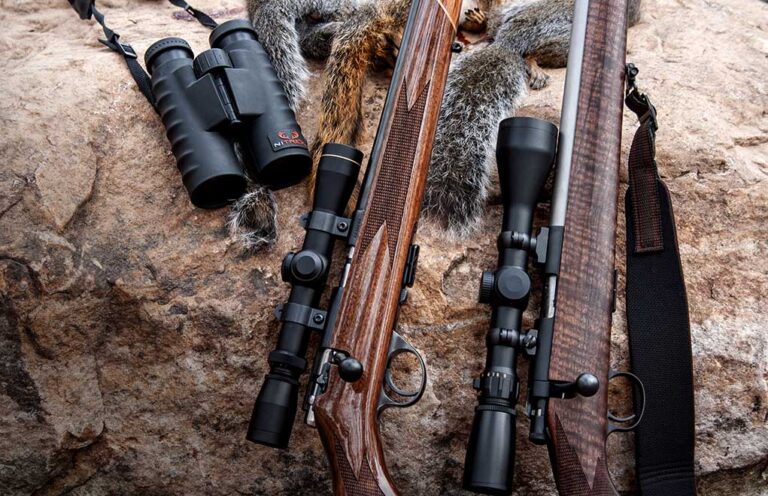
We test today’s top .22LR hunting ammo for precision, velocity, cost and terminal performance.
Not too long ago, I tested 20 different loads of .22LR ammo to see which one would deliver the most precision on target out of my favorite .22 rifle. I was astonished to discover that the best shooting load was designed for small game hunting. In fact, five of the seven most precise shooting loads from my rifle were suitable for small game hunting. This got me to wondering how these same loads might shoot in other rifles, so another test was conducted.
I took those five good-shooting hunting loads and tested them in two other rifles. Like with my favorite rifle, I fired five, five-shot groups at 50 yards with each load out of each rifle. And I also—just like the test with my rifle—chronographed the first 10 shots fired with each load. My rifle (Rifle 1) is a New Ultra Light Arms single-shot with a Douglas Barrel and a Timney trigger. Rifle 2 was a custom 10-22 with a Green Mountain barrel and a Timney trigger. And the third rifle (Rifle 3) was a box-stock Smith & Wesson M&P 15-22. Each rifle was outfitted with a riflescope set at a magnification of 6X.

The most precise-shooting load overall was the best-shooting load out of only one of the rifles. In fact, it was the worst shooting load out of my rifle. This was a bit surprising since my rifle—on average—produced groups that were about 40 percent smaller than the other two rifles. This clearly illustrates that rimfire rifles are finicky creatures. Just because one rifle prefers a certain load doesn’t mean another rifle will. As you can see, each rifle had its favorite.
Velocity
Conventional wisdom suggests that rimfire ammunition producing consistent velocities will also produce good precision. Out of my rifle (Rifle 1), the most consistent velocity was registered by CCI’s 40-grain LFB (lead flat-nose) SGB (small game bullet). However, from a precision standpoint, it came in fourth. The load with the least consistent velocity out of my rifle was the 40-grain, CCI Mini-Mag Segmented HP (hollow-point) load. It was the most accurate. This would suggest that conventional wisdom doesn’t apply.
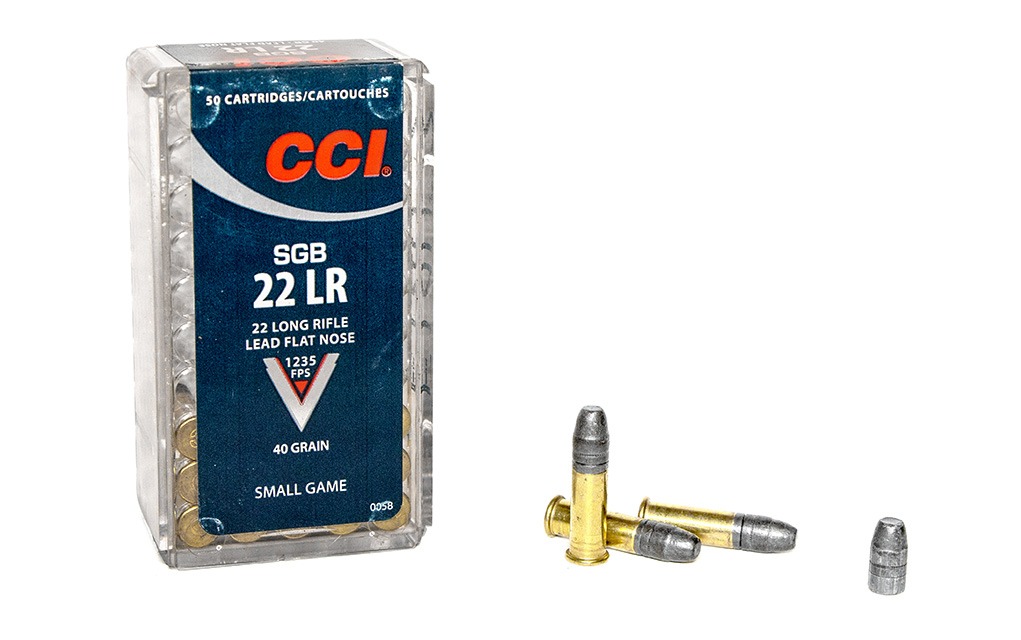
On the other hand, when all the rifles were considered, the most precise shooting load was the 38-grain Federal American Eagle load. If the average velocity consistency from all three rifles is compared, this load also performed the best. The load that delivered the least consistent velocities across all three rifles was the Winchester Hyper Velocity 40-grain CPHP (copper-plated hollow-point) load. It ranked fourth in terms of average precision. This would seem to suggest that, at least when multiple rifles are considered, velocity consistency does influence precision.

Another comment regarding velocity is worth making. Rarely, if ever, do actual velocities meet or exceed advertised velocities, and that was proven in this test. However, the differences were very consistent. When all five loads and all three rifles were considered, the average difference in advertised and actual velocities was only 33 fps. Just as interesting was that the range of variance was only 12 fps. This means you can expect your actual velocities to be less than advertised, but reasonably close.
VELOCITY
| LOAD | ADV (fps) | AMV (fps) | AVD (fps) | ASD (fps) | AES (fps) |
| Federal American Eagle 38-grain CPHP | 1,260 | 1,224 | 36 | 16 | 53 |
| CCI Mini-Mag 40-grain Segmented HP | 1,235 | 1,206 | 29 | 17 | 59 |
| Federal Champion 36-grain CPHP | 1,260 | 1,233 | 27 | 18 | 54 |
| CCI 40-grain LFN SGB | 1,235 | 1,203 | 32 | 19 | 63 |
| Winchester 40-grain Hyper Velocity CPHP | 1,435 | 1,396 | 39 | 24 | 71 |
| AVERAGES | 33 | 19 | 60 |
Cost
For as long as I can remember, I’ve been told that the best shooting .22 Long Rifle loads cost the most. If you’re shopping for .22LR ammo and your primary concern is precision, most likely you’ll purchase the most expensive load, hoping to find that precision. Out of the 20 loads I originally tested in my rifle, this wasn’t the case. The two most expensive loads ranked 13th and 14th in terms of precision.
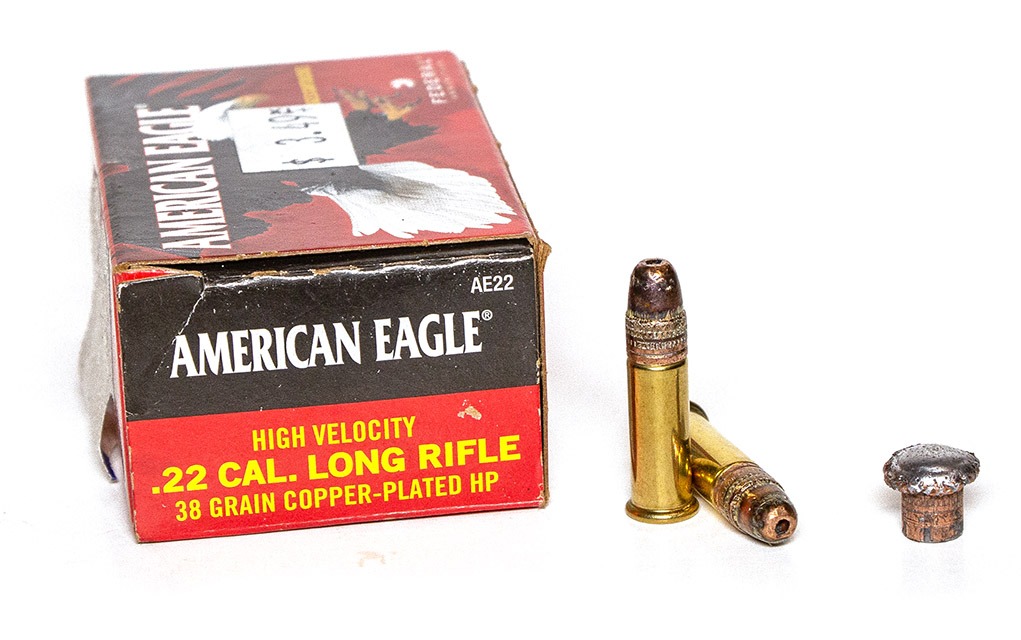
Just looking at the five hunting loads fired out of the three different rifles for this test, one of the least expensive loads, which was the 38-grain Federal American Eagle load, delivered the best precision. Between all three rifles, the most expensive load ranked third in terms of precision. Cost, it’d appear, has little to do with the precision you can expect from .22LR ammo.
COST
| LOAD | CPS (cents) | AP (inches) | ASD (fps) |
| Federal American Eagle 38-grain CPHP | 12 | 1.12 | 16 |
| CCI Mini-Mag 40-grain Segmented HP | 13 | 1.16 | 17 |
| Federal Champion 36-grain CPHP | 10 | 1.41 | 18 |
| CCI 40-grain LFN SGB | 22 | 1.31 | 19 |
| Winchester 40-grain Hyper Velocity CPHP | 15 | 1.36 | 24 |
| AVERAGES | 14 | 1.27 | 19 |
Terminal Performance
All of this is interesting, and while it might suggest that a certain load has the most potential to shoot well from your rifle, there’s no guarantee. As stated, for each rifle there was a different load that delivered the best precision. However, I don’t think it’s a stretch to suggest that at least one of the five loads that were tested should shoot very well out of your rifle. And precision is important. If you want to head shoot a squirrel at 50 yards, you’ll struggle to do it with a load not capable of shooting groups less than, or at least very close to, 1 inch at that distance.
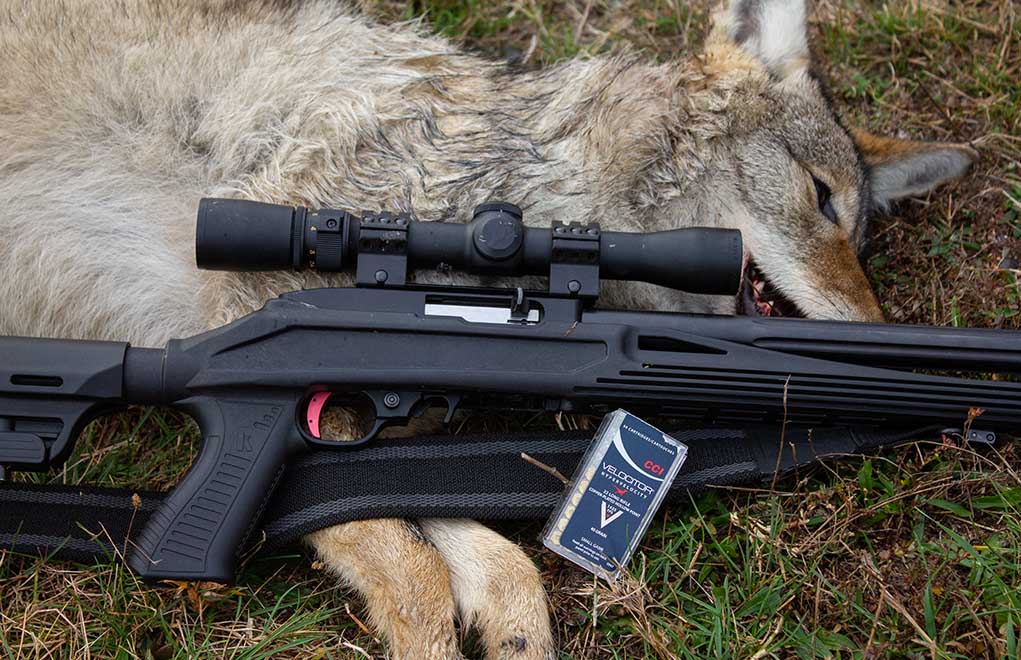
A shot to a squirrel’s head with any bullet fired from a .22 rifle will do the trick, but your small game hunting might include larger critters, such as raccoons, fox, bobcats—and even badgers and coyotes. If that’s the case, head shots will still work, but you’ll likely want a load that’d deliver good terminal performance if a body shot must be taken. With that in mind, I thought it would be interesting to compare the terminal performance of these five loads.

For that test, I fired one shot from each load out of each of the rifles into blocks of Clear Ballistics Gel placed at 20 yards. The chart reflects the average of these results. For those who believe kinetic energy matters, the muzzle energy, based on the average velocity of each load from all three rifles, is included as well.
The terminal performance of these five loads was varied. This is a good thing because it gives you some variety based on what you plan to shoot. The CCI Mini-Mag 40-grain Segmented HP is unique in that the bullet breaks into three pieces after penetrating about an inch. Then, the three pieces radiate out from the primary bullet path by about an inch and a half, and then only penetrate to about 6 inches. This load should deliver massive wounding, but of course, penetration will be limited. The other unusual load was the CCI 40-grain LFN SGB. This is a non-deforming bullet designed for maximum penetration, and that’s what you get; it penetrated 14 percent deeper than the next deepest penetrating load.
The three remaining loads penetrated to about a foot, and two of them showed moderate deformation. But surprisingly, the standout load once again was the Federal American Eagle 38-grain CPHP. The bullet from this load deformed with a frontal diameter noticeably larger than the other two. Though this load was one of the least expensive, on average it was the most precise shooting, delivered the most consistent velocities, and arguably the best terminal performance.
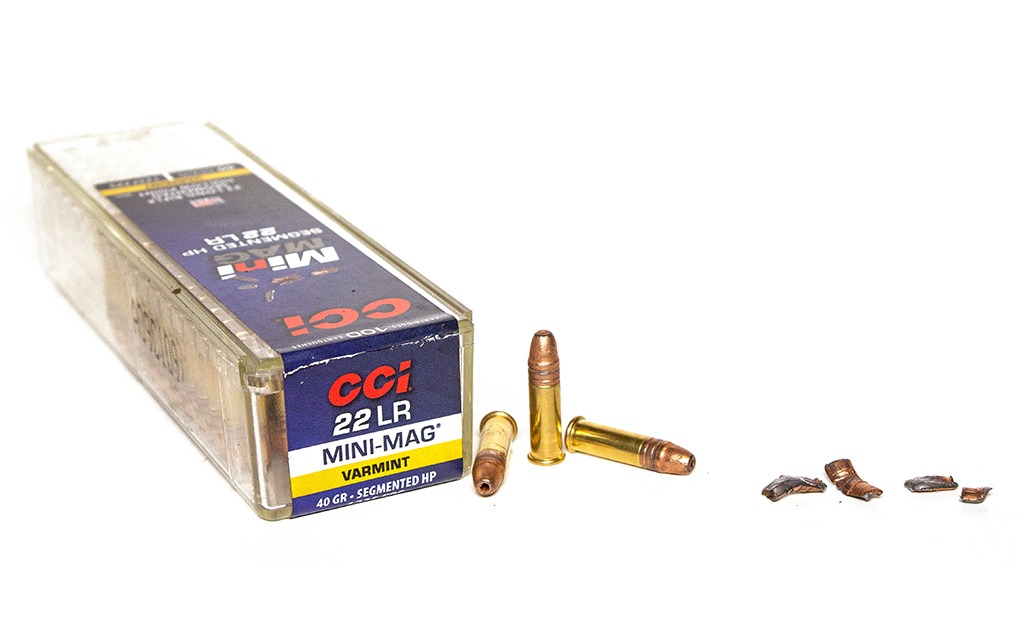
CCI’s Mini-Mag 40-grain Segmented HP proved to be the best shooting load in my rifle. Considering the small game I hunt and this load’s terminal performance, it should do nicely. If I find it on the shelf, I’ll buy in bulk. Given ammo availability right now, you might not be able to assemble a collection of loads to test. That’d for sure be the best course of action. However, whether you can obtain several loads to test or not, I’d strongly suggest you give the very inexpensive American Eagle load a try.
TERMINAL PERFORMANCE
| LOAD | ENG (ft-lb) | PEN (in.) | RBD (in.) | RBW (gr.) |
| CCI Mini-Mag 40-grain Segmented HP | 129 | 6.0 | f | 37f |
| Winchester 40-grain Hyper Velocity CPHP | 173 | 11.0 | 0.297 | 32 |
| Federal Champion 36-grain CPHP | 121 | 14.0 | 0.274 | 37 |
| CCI 40-grain LFN SGB | 128 | 16.0 | 0.221 | 40 |
| Federal American Eagle 38-grain CPHP | 126 | 12.5 | 0.348 | 38 |
| AVERAGES | 135 | 11.9 | 0.285 | 37 |
Editor's Note: This article originally appeared in the September 2022 issue of Gun Digest the Magazine.
Raise Your Ammo IQ:
- Beyond The 6.5 Creedmoor: The Other 6.5 Cartridges
- The Lonesome Story Of The Long-Lost 8mm
- Why The .300 H&H Magnum Still Endures
- .350 Legend Vs .450 Bushmaster: Does One Win Out For Hunting?

Next Step: Get your FREE Printable Target Pack
Enhance your shooting precision with our 62 MOA Targets, perfect for rifles and handguns. Crafted in collaboration with Storm Tactical for accuracy and versatility.
Subscribe to the Gun Digest email newsletter and get your downloadable target pack sent straight to your inbox. Stay updated with the latest firearms info in the industry.

![Best Concealed Carry Guns In 2025 [Field Tested] Wilson Combat EDC X9S 1](https://gundigest.com/wp-content/uploads/Wilson-Combat-EDC-X9S-1-324x160.jpg)


![Best 9mm Carbine: Affordable PCCs [Tested] Ruger Carbine Shooting](https://gundigest.com/wp-content/uploads/Ruger-Carbine-Shooting-100x70.jpg)
![Best AR-15: Top Options Available Today [Field Tested] Harrington and Richardson PSA XM177E2 feature](https://gundigest.com/wp-content/uploads/Harrington-and-Richardson-PSA-XM177E2-feature-100x70.jpg)

Having shot hundreds of squirrels (urban designer rats that I had no intention of eating) with a .177 pellet, I have some information about shot placement. Head shots need to get in the brain cavity to be effective, otherwise you get a squirrel with a mangled jaw that requires a follow up. Probably not an issue with a 22. Body shots are effective. You either hit the heart and the squirrel gets the dead mans 5 seconds and runs like mad until it dies in mid-stride or you hit the lungs and get the chin up of death as it bleeds out and slowly slips off the branch. Neck shots are the best as there are all kinds of stuff there, spine, big blood vessels, windpipe but also you get a good chance of a bounce up into the brain or down into the heart/lung area.